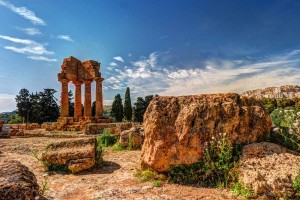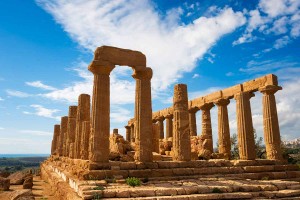
©Bigstock.com/Romas_ph
Numerous peoples and nations left their traces in Italy over the course of centuries and millennia. Both the mainland and the island evoke the memories of former world powers and great regents. In pre-Christian times Sicily mainly served as a Greek colony. The Hellenes built numerous cities, enormous temples and monuments, some of which even survived Punic and Roman conquests. What is likely the island’s most important archaeological area was declared UNESCO World Heritage Site in 1997. It is situated in Agrigento, south of today’s town centre, and illustrates the erstwhile Greek glory particularly impressively. If you’re interested in history, you absolutely must visit the Valley of the Temples!
Akragas and the Valley of the Temples through the ages
Agrigento’s archaeological world heritage site mostly covers the old Greek city Akragas. It was founded during the second wave of Greek colonisation around 582 BC and quickly became the second most important polis on Sicily behind Syracuse. Located on an elevated plateau, Akragas provided excellent defensive options thanks to the steeply sloping terrain and several rivers. Massive city walls would prove to be an unbreachable obstacle for centuries. Being well-protected against enemy troops allowed its rulers to gradually strengthen and expand the polis. Several temples and an acropolis were built, the walls were extended.
Several conflicts later the Romans had destroyed Akragas around 261 BC, just before Carthaginian conquests began. Having finally been taken over completely by the Roman Empire and re-named Agrigentum, the city once again prospered before being largely abandoned and left to deteriorate after Vandal raids. German authors Goethe and Seume would rediscover the area documenting their experiences in their travel diaries. This inspired extensive archaeological excavations in the 19th century. Nowadays, the Valley of the Temples mostly struggles with the slow decay of the ancient building material limestone as well as some areas having been declared building land that even saw some illegal construction work throughout the valley.
Characteristics of the temples

©Bigstock.com/afinorcchiaro
But what is it that makes the temples in the Archaeological Area of Agrigento different than comparable monuments of ancient Greek architecture? On the one hand, there’s the building material. While you mostly find marble architectures in and around Athens itself, Agrigento relied on limestone that was found in the nearby Akragas river valley. A layer of stucco gives it that marble look. In addition, the temples followed front-accentuating layouts, as the wide perron and the sacrificial altar, where ceremonies with animal sacrifices took place, show you. The Olympeion, however, is a bit different, as it displays Carthaginian elements, such as pillars (instead of columns). It was built after a victory of the Greek over the Carthaginians.
A walk through the Valley of the Temples
The Archaeological and Landscape Park of the Valley of the Temples unites the most important remains of Greek settlements along the southern city walls as well as some sanctuaries dating back to even earlier times. Don’t let the name confuse you – this isn’t really a valley, but more of an elevated plateau. Enough talk, let us introduce you to some of the park highlights you absolutely must see during your guided tour:
- Olympeion: Having defeated the Carthaginians in the Battle of Himera around 480 BC, the tyrant Theron ordered construction of the Temple of the Olympian Zeus. Carthaginian architectural elements were employed to symbolise Greek superiority. The Olympeion was the third-largest temple in all of ancient Greece ever. Only a few ruins of the walls and pillars were left after the colony had been conquered by the Carthaginians. Oh, the irony.
- City walls: The walls at the south side were carved from the rock. You can see Byzantine-era sepulchres at the inner face.
- Temple of Heracles: Likely built in the 5th century BC, this temple rests on a three-step fundament. Its ruins are spread across the entire archaeological area, the columns were re-erected in 1924.
- Temple of Hera Lacinia: Actually, this temple wasn’t dedicated to Hera – it’s a mix-up, the real divine dedication is unknown today. 25 of what were once 34 pillars now rise into the sky. Some of them stilly carry their capitals and an architrave.
- Gardens of Kolymbéthra: This valley basin was originally used for water drainage and supply. Silted in later days, it became home to fertile fruit and vegetable gardens. Some of the trees and plants are hundreds of years old. The ancient aqueducts are now used for garden irrigation.
- Temple of the Dioscuri: Reconstructions of this temple caused tremendous controversy among experts. Its quaint look was rejected to the greatest extent possible as it mashed parts of various stylistic periods together. Still, the temple facilities are certainly worth seeing.
- Temple of Concordia: Being the polar opposite to the Temple of the Dioscuri, the Temple of Concordia is probably the one truest to its original form in the entire park. It rests on a pedestal that levels out ground unevenness and was used as a Christian basilica until the 17th
- Early Christian necropolis: Grave sites were installed between the Temple of Concordia and the Temple of Heracles between the 3rd and 9th century AD. Unfortunately, the catacombs below are closed for the public.
- Sanctuary of the Chthonic Gods: The Greeks worshiped their gods even before Akragas was colonised. The oldest parts of this sanctuary date back to the first half of the 6th century BC.
Other structures and sites
Agrigento’s archaeological sites know many other, additional highlights stretching around the Archaeological and Landscape Park. We picked a few of our favourites for you:
- Poggetto San Nicola: A small hill, Poggetto San Nicola, rises in the heart of the ancient city. You’ll find a small Cistercian church with a Romanesque façade on this lift. The marble reliefs in the side chapel, however, are of Greek origin, The Archaeological Museum unites major findings from Agrigento and its surroundings, such as a Roman child sarcophagus and a telamon from the Olympeion.
- Temple of Hephaestus: Located just inside the ancient city walls, yet outside the park, this is the youngest of the classic Akragas temples. Sadly, only two pillar ruins survived.
- Temple of Asclepius: More recent excavations uncovered a complex of buildings around this temple outside the city. According to Cicero, a statue of Apollo was once kept here.
- Acropolis: Originally, there were two temples – dedicated to Zeus and Athena – on the acropolis, which stretched across two hills. Their ruins remain hidden. Experts believe that the church Santa Maria dei Greci was built on the former site of the Athena temple.
Unbowed fascination follows the Archaeological Area of Agrigento to this very day. The mix of old ruins and attempted reconstructions still manages to enchant in a manner that is hard to put into words. In other words, you absolutely have to travel to the Valley of the Temples. Once you’ve set a foot inside this park, you can virtually feel the eventful history of this place. Don’t miss out on this and many other ZAINOO top destination!